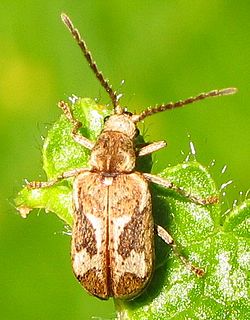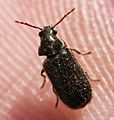Anobiidae facts for kids
Quick facts for kids Anobiidae |
|
|---|---|
 |
|
| Fan-bearing wood-borer, Hedobia imperialis | |
| Scientific classification | |
| Kingdom: | |
| Phylum: | |
| Class: | |
| Order: | |
| Infraorder: |
Bostrichiformia
|
| Superfamily: |
Bostrichoidea
|
| Family: |
Anobiidae
|
Anobiidae (say "Ah-no-BEE-uh-dee") are a family of small beetles. You might know some of them better as "woodworms" or "wood borers." That's because their young, called larvae, love to munch on wood! These tiny creatures can sometimes cause big problems by damaging wooden furniture, floors, and even parts of houses.
Contents
About Anobiidae Beetles
Anobiidae beetles are part of a huge group of insects. They are known for their ability to digest wood. This special skill makes them important in nature. They help break down dead trees. However, it also means they can become pests when they get into our homes.
What are Woodworms?
The term "woodworm" actually refers to the larvae (the young stage) of these beetles. Adult Anobiidae beetles lay their tiny eggs on or just under the surface of wood. When the eggs hatch, out come the larvae. These larvae are usually pale, C-shaped, and have strong jaws. They start to tunnel into the wood, eating their way through it. This is where the damage happens.
- The larvae spend most of their lives inside the wood. This can be anywhere from a few months to several years.
- As they eat, they create tunnels. They also leave behind a powdery dust called "frass." This frass is actually their droppings. It looks like fine sawdust. Finding frass is often the first sign of a woodworm problem.
- Once the larva is fully grown, it changes into a pupa inside the wood. This is a resting stage.
- Finally, the pupa changes into an adult beetle. The adult beetle then chews its way out of the wood. It leaves a small, round exit hole. These holes are another clear sign of woodworm activity.
Famous Wood-Damaging Beetles
Not all Anobiidae beetles are pests. Many live in forests and help recycle dead wood. But a few species are well-known for causing damage to human structures.
- Common Furniture Beetle (Anobium punctatum): This is probably the most common woodworm in homes. It attacks softwood and some hardwoods. It loves old furniture, floorboards, and roof timbers. The exit holes it leaves are small, about 1-2 mm wide.
- Death Watch Beetle (Xestobium rufovillosum): This beetle is larger and causes more serious damage. It prefers old, damp hardwood, especially oak. You might hear it! The adult beetles make a tapping sound. They bang their heads against the wood. This is a mating call. In quiet old houses, this tapping sound was once thought to be a sign of death, giving it its spooky name.
How to Spot Woodworm Damage
It's important to know the signs of woodworm. Catching it early can save your wooden items.
- Small, round holes in wooden surfaces. These are exit holes where adult beetles have emerged.
- Tunnels visible on the surface or inside the wood if you cut it open.
- Powdery dust (frass) around or beneath the holes. This looks like fine sawdust.
- Weak or crumbling wood, especially at edges or corners.
- Adult beetles themselves, often found near the damaged wood, especially in spring or summer.
If you find these signs, it's a good idea to tell an adult. They can help figure out if treatment is needed to protect the wood.
Images for kids
See also
 In Spanish: Ptinidae para niños
In Spanish: Ptinidae para niños



